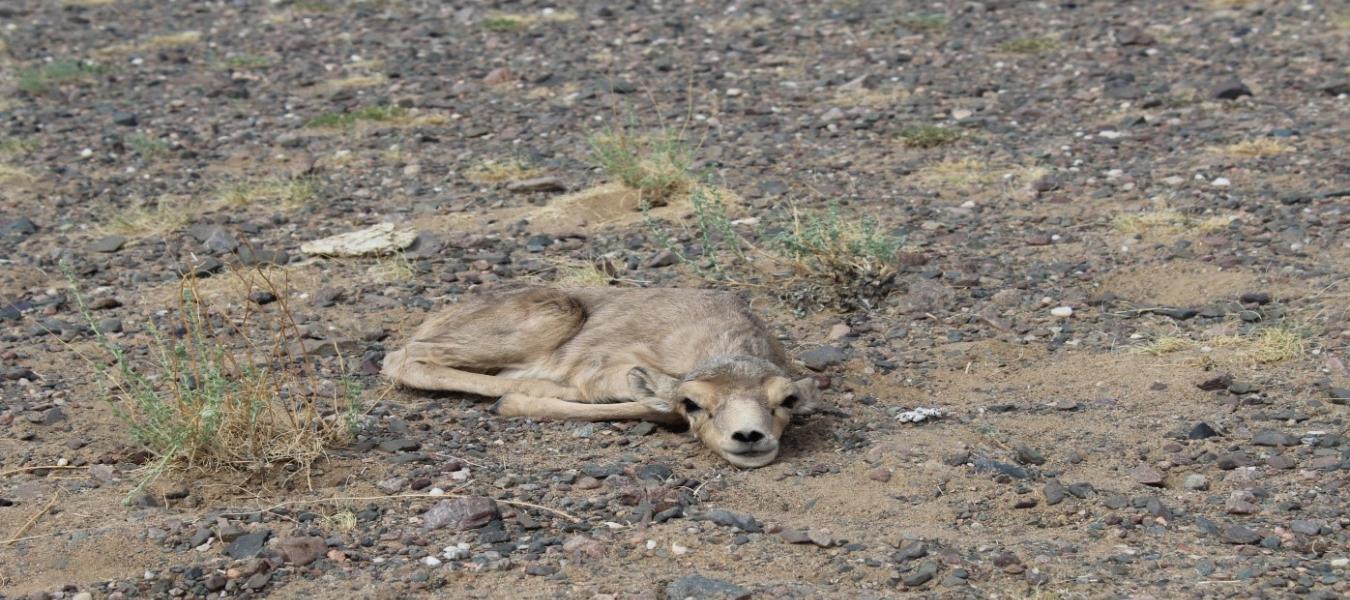
The Saiga saga: Mongolian edition
Munib Khanyari, Bristol University, munib@ncf-india.org
During the rutting season, a PPR (Peste des petites ruminants) outbreak, transferred from livestock, decimated 54% of the saiga population. The calving in June 2017 could perhaps be crucial to sustain this thinning population. We were here with two missions; to monitor saiga calving, and to collect samples to see if they have developed PPR antibodies in reaction to the outbreak. Finding saiga babies can be a challenging task. For four days we spotted none. As our vehicle traversed the steppe, we spotted a few saiga carcasses - a grim reminder of the plague.
As the fifth day passed without sighting calves, we were starting to despair. Two local vets had told us that, following the PPR outbreak in livestock in September 2016, many female sheep and goats had aborted their pregnancies. Was the same happening to saigas?
As we sat under the baking Gobi sun, we spotted a group. Excitingly, a female was accompanied by two smaller saigas. Suddenly, they sat down and disappeared. This was the moment! Upon reaching the site, we found twins! The team was ecstatic to finally spot calves. However, one of them weighed 2.2 kg, the lowest recorded for a Mongolian saiga calf. A normal Mongolia Saiga baby weighs around 3 kg. Was the plague responsible?
Over the next 4 days, we spent over 10 hours a day searching. The calves remained elusive. In these bleak times, teamwork was crucial. Upon sighting what seemed to be a distant suckling female, as we scanned from atop a hill, Buyanbaatar, a local ranger, fixed the spotting scope with her in his gaze. Buuvei, another ranger, and I sat in the car, switching on our walkie-talkies. Buyanbaatar guided us and we found a tiny calf.
In the end, we only found 9 calves, a pair of twins and some singletons, many fewer than our projected 40 (the number found in previous monitoring expeditions). Some were a few days old and extremely hard to catch! Maybe the saiga did lose their pregnancies or were not mated due to PPR. We could only speculate!
As we sat in the Darvi soum (provincial capital), on our way back to Ulaanbaatar, we reminisced about the steppe. This year's calf monitoring had been tough; filled with gusty desert winds, long hours of scanning and only 9 calves. Nonetheless, we were happy to get blood samples from each, which were to be tested in the Veterinary lab in Ulaanbaatar for presence of PPR antibodies and Pasteurella (in 2015 in Kazakhstan saigas died from pasteurellosis, when the commensal Pasteurella bacteria turned virulent). Additionally, we collected information on saiga group sizes and structure and the proportion of pregnant females, to see if trends in these were affected by the plague. We also collected teeth from dead individuals for aging.
Upon reaching Ulaanbaatar we learnt of ibex deaths near our field site. Many of the nearly 20 dead animals had been diagnosed with PPR. Has the disease slipped into the mountain ungulates? I contemplated this and simultaneously thought of the saiga. Against all the odds, this creature which once lived with the mammoths, has survived in one of the most hostile environments on Earth. With that thought I rested my head and believed that the last chapter of this long story that is the saiga, isn't definitely written yet!
The entire saiga calf monitoring team taking a break in the Darvi soum near the Saiga calving grounds in Shargiin Gobi; One of the nine saiga calves that were spotted during the calving. Notice the impressive camouflage. Photos by Munib Khanyari
